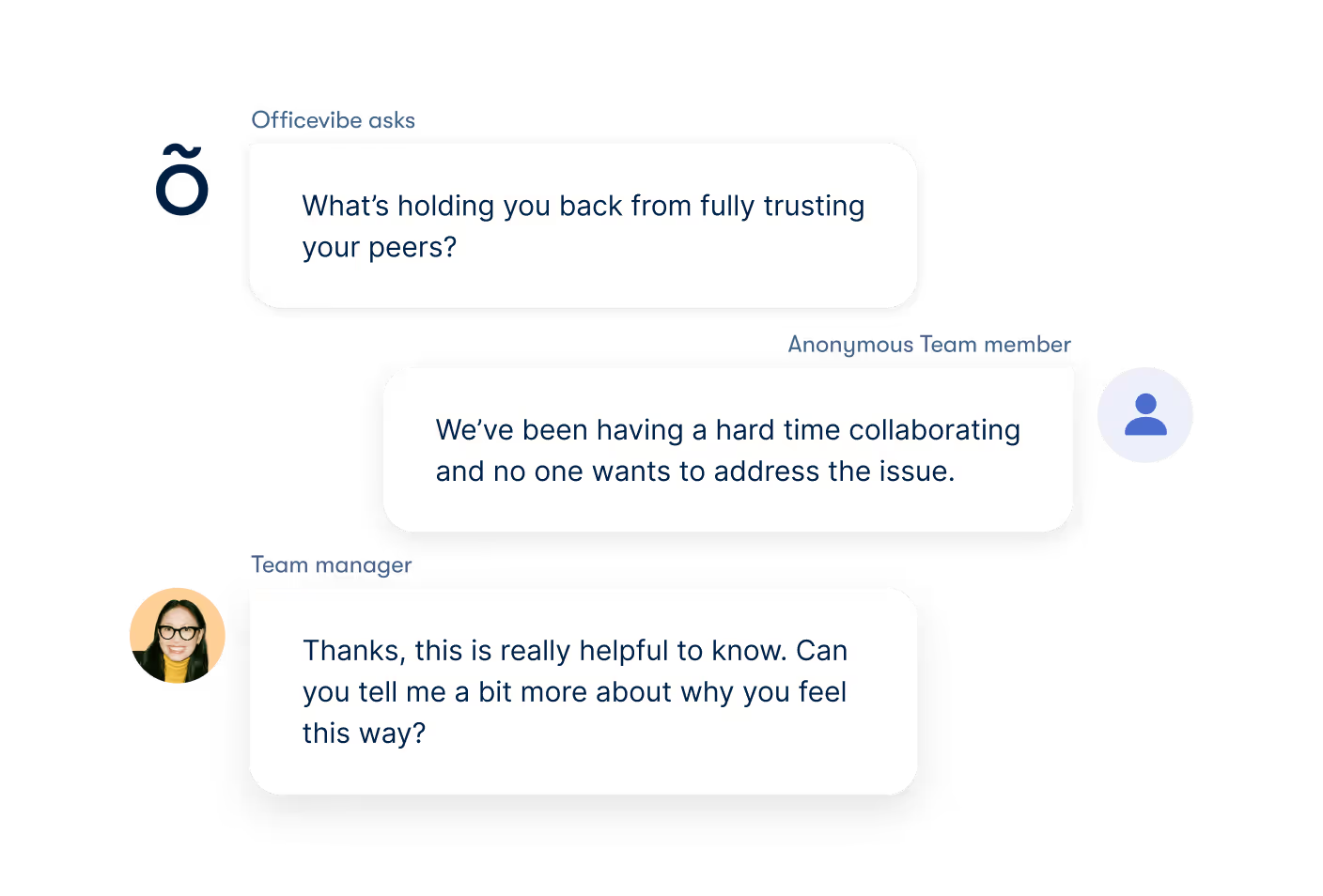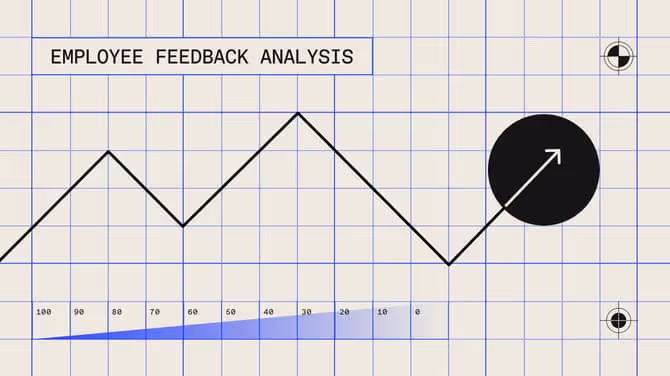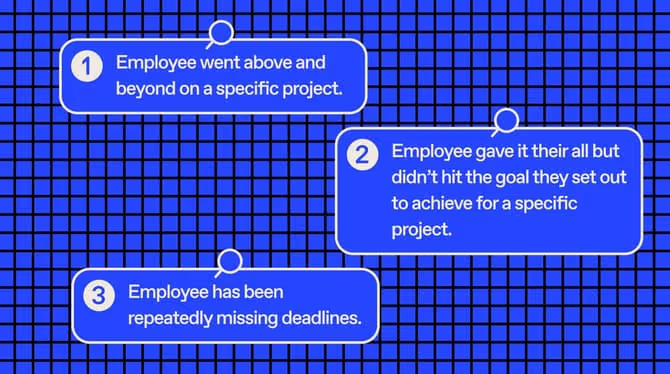Importance of employee feedback

Discover Workleap Officevibe's benchmark report on 12 key employee engagement metrics

1 in 5 employees is unsatisfied with the frequency of feedback from their direct manager. And almost 30% of employees wish they had more peer feedback.
Providing feedback is important because it makes employees feel like they're a part of something greater. When employees feel like they're a part of the company, they become more engaged with its vision and values.
Giving and receiving feedback is an essential part of fostering this engagement. Effective communication builds solid relationships, retains top talent, expands and retains customer base, and elevates your employer brand.
Why is employee feedback important?
Employee feedback is important because when given constructively it:
- enables ongoing development
- helps identify and removes blockers to reach targets and objectives
- strengthens the relationship between manager and employee, as well as peer-to-peer feedback
- makes employees feel supported in their role
All in all, these benefits and more contribute to overall positive employee engagement.
In turn, on an organizational level, employee feedback is important because it directly impacts both human resources and key performance indicators like employee retention, employee morale, company culture, and skills building.
Let's zoom in on each of these further.
Increases employee retention
Did you know that providing employee feedback can directly impact your company's employee retention rate?
Your employees will appreciate it when you give them healthy positive and negative feedback. They are more likely to invest their time and abilities to grow your business and even decline job offers from other companies!
And with the battle for talent these days, all leaders can understand how losing employees and hiring a replacement is expensive, often costing companies thousands per hire.
Turnover and unfulfilled positions contribute to lower employee engagement. When overworked, people feel tired, dissatisfied, and risk burnout—all predicators to leaving a job. You can see how it can quickly turn into a dangerous cycle.
Enhances employee morale
Fact: Happy, satisfied employees who show a positive attitude at work have high morale and impact overall team morale. In contrast, those dissatisfied with their environment display lower levels of confidence.
{emphasize}
Read more on how to tackle low employee morale.
{emphasize}
You can influence your employee's morale by providing positive feedback. If a person knows that they're doing an excellent job at work, they are more likely to feel emotionally at ease and less pressured.
{emphasize}
Boosting your employee morale can have a tremendous impact on your ROI. Happy employees are more productive and engaged.
{emphasize}
Build a positive company culture
A positive workplace culture raises teamwork, performance levels, and efficiency. In turn, your employees are undoubtedly more satisfied with their jobs.
Creating a positive workplace entails a lot of trust and honesty. Implementing an effective employee feedback process can help you create a work culture where your employees thrive.
With the help of your team, ask your direct reports what would help them live out the company's core values. Ask their feedback on what could help the organization improve overall work processes and policies.

Create a highly-skilled workforce
Continuous learning supports your people's career development (aka a significant factor in engaging and retaining them).
Training programs also improve your company's bottom line. Upskilling accelerates your employee's abilities, creativity, and innovation. As a result, you can deliver more services, develop more products, and eventually earn more profits.
{emphasize}
Support your learning and development initiatives with actionable feedback. If your employees aren't learning and benefiting from the training, there's no reason to do it.
{emphasize}
What are the benefits of employee feedback?
Providing employee feedback is vital because it helps clarify expectations and helps people learn from their mistakes. But giving and receiving feedback can be challenging.
Above all, it's important to stay objective and respect the other person to benefit from the conversation.
Giving feedback to employees
Feedback helps make your employees feel more confident in their performance and more committed to showing positive behavior. By making them aware of their skills and strengths, you give them a sense of value in the workplace – the key to employee success.
Providing employee feedback also helps your workforce develop their careers.
According to the article from Netsuite's Barnyard, much of Gen Z has been conditioned to expect immediacy. Managers can avoid giving vague feedback by sharing it immediately after a project instead of waiting until the following performance review.
{emphasize}
With the right technology and resources, you can establish an employee-driven feedback culture where people are free to exchange feedback with their colleagues and superiors.
{emphasize}
Getting feedback from employees
Receiving employee feedback is the quickest way to improve your leadership.
When you take time to hear your employees' constructive feedback, you'll gain insights into precisely what is happening within your organization at all levels, which can help you make informed decisions.
Feedback also helps you prevent workplace conflicts before they happen
As a manager, you need to lead the right conversations in the workplace. When conflicts arise, explain that gathering feedback is to discuss, not debate or take sides.
When your employees handle feedback effectively, it can foster a culture where disagreements are handled openly and directly while also being sensitive. Honest communication is key to smooth working relationships.
Types of employee feedback
There are three main types of employee feedback:
Positive feedback
Positive feedback emphasizes your employee's strengths and accomplishments.
When you provide positive feedback, the goal is to reinforce positive behavior at work. It can also enhance employee confidence.
{emphasize}
Example:
Congratulations on the client presentation today. I love the case studies you've included from our long-term clients. The slides looked impressive too.
I'm looking forward to your next presentation. Keep it up!
{emphasize}
Negative feedback
Negative feedback highlights behaviors that need to stop to prevent poor work performance or discourage negative impact on the team.
{emphasize}
Example:
I want to talk to you about your tardiness for the past few days because it affects the team's productivity. We would all appreciate it to see you come to work on time again. How can we make that happen?
{emphasize}
Constructive feedback
Constructive feedback is given to an individual to pinpoint areas of weakness, followed by strategies to address shortcomings.
It is helpful to provide specific examples that your employees can follow with constructive criticism.
{emphasize}
Example
Your work on tasks A & B was good. I know you couldn't finish project X. Let's chat to rethink your deliverables and goals. What do you think?
{emphasize}
{highlight}
💡 See our top 15 employee feedback examples.
{highlight}
How to ask for employee feedback
Now that you know the benefits and the types of employee feedback, it's equally crucial to understand how to ask for employee feedback properly.
Below are strategies for receiving feedback gracefully:
Ask your team for feedback
When asking for feedback, use open-ended questions like 'How can I improve our weekly team meetings?
Or try asking specific questions like 'Do you need my help to prepare the monthly sales report?'
Pro tip: Encourage honest feedback from hesitant employees. Officevibe's feedback tool allows team members to anonymously share their questions and ideas with their managers. Managers can reply to the feedback from the direct reports.

Ask for regular feedback
The primary reason people struggle with giving and receiving feedback is not lack of proficiency but frequency.
Don't wait for the scheduled performance appraisal to ask for feedback.
Be proactive and check in with people promptly, especially after reaching a particular milestone. Or even in the middle of a big project.
Frequent check-ins allow you to answer issues quickly before it becomes more significant.
{emphasize}
Consistent feedback also fosters more openness that forges closer work relationships.
{emphasize}
{highlight}
📝 Need a little help establishing comfortable grounds for feedback? Dive deep into your communication habits and find out how to improve during your one-on-one using our free discussion on team member/manager meeting template.
{highlight}
Don't forget to say 'Thank You' after you receive feedback
Receiving feedback sometimes can be hard to accept, especially constructive criticism. But always think that it's to your advantage to hear such things for your own good.
Giving honest feedback is not easy, so you need to appreciate them when they come by.
Employee feedback loop
Put your feedback into action by having an employee feedback loop.
Include the action items discussed in your last feedback with your staff and follow up on your next meeting.
To have a successful employee feedback loop, remember to keep it objective. Practice active listening to gain a complete picture of the situation.
[ov_cta id="5116629"]
Lastly, meet in person to make the feedback more personal and transparent. When you meet face-to-face (even if virtually), you can clarify points and notice nuances that won't be possible when receiving feedback via email or chat.
Why employee feedback matters
Employee feedback is important because it impacts the manager-direct report relationship and organization.
To have an effective employee feedback system, it's essential to know the benefits and the different types of feedback and when to use them.
Finally, asking for employee feedback and having feedback loops in place is crucial to having a good working relationship with your staff, vital to your company's success.
Give HR and managers the clarity, confidence, and connection to lead better every day.


%20(1).avif)


.avif)
.avif)








.avif)